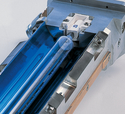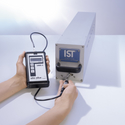Responsible cost reduction
14 October 2008In the current climate of high energy prices, printers need their suppliers to help reduce production costs
Any measures that can reduce the overall energy requirements of a UV curing system clearly have the potential to offer the printer cost savings. As well as the more obvious cost savings that can be gained by reducing energy requirements, savings can be gained from a reduction in downtime as a result of intelligent system design. Any such savings make more production hours available which, in turn, should increase the level of throughput and profitability.
There are a number of design features that manufacturers can incorporate into UV curing systems to help minimise downtime and other associated costs.
For optimum cure efficiency and component longevity, it is necessary to regularly clean reflectors and lamps and, depending on pressroom conditions, this operation should ideally be carried out about once a month. Lamps and reflectors also need replacing when they reach the end of their working lives. With the average warranty on lamp life being 1,000 hours and the life of an average reflector being around 3,000 hours, this means a printer working 24/7 with between 50 and 70 per cent uptime will be changing lamps roughly every 2-3 months and reflectors at least once a year.
Design features that enable these operations to be carried out more rapidly have a positive impact on downtime. For example, by using a cassette system, that just slots into an external lamp housing, the lamp and reflector can be simply pulled out of the housing when maintenance and cleaning is required. This kind of approach to system design makes all components readily accessible and reduces the amount of time required for lamp and reflector cleaning or replacement.
IST, for example, has incorporated this feature in a number of its UV curing systems and to further improve efficiency the company has developed a patented cable-free fast lamp change (FLC) system where the UV lamp just plugs into the UV reflector cassette in a similar manner to a fluorescent tube. As there are no parts to unscrew or cables to disconnect, an electrician is not required and, according to the company, a trained operator is able to remove a lamp from the system in a few simple steps that take a matter of seconds.
With the lamp removed from the lamphead, all components are more accessible, making accomplishing these tasks much easier, faster and more efficient. The speed and ease of lamp removal that these design features facilitate, encourages regular cleaning, while at the same time minimising associated downtime, says IST.
The vast majority of UV curing systems employ medium pressure mercury arc lamps, the output of which diminishes gradually over a period of time. IST in common with other manufacturers provides a standard warranty of 1,000 hours.
“This is a very conservative estimate of the life of our lamps, which are all manufactured and tested in house to an exacting standard,” says managing director of IST UK Simon Mitchell. “Under the right conditions, the effective life of a lamp has been proven to be significantly longer than this. Particularly favourable conditions for extended lamp life are offered by our latest low wattage UV curing systems, especially where these have electronic power supply units.”
By increasing the effective life span of UV lamps, a printer can make cost savings from the fact that fewer replacement lamps need to be purchased and also from reduced downtime, as less lamp changes are required. However, there is no room for guesswork here and a suitable measurement system is required for quantifying the lamp output.
IST’s latest MBS-5 and BLK-5 systems are both prepared for UV measurement as standard. The lamp housing has a small access point into which the probe of a mobile UV measurement system can be inserted. This is said to enable rapid, accurate and repeatable measurement of the spectral output of the UV lamp and makes it possible for a printer to determine exactly when a lamp has reached the end of its useful life span.
In addition, being able to measure lamp output directly in milli joules per centimetre offers full control over production parameters and enables the printer to set the optimum power for each print job. This further reduces energy consumption and also helps to optimise lamp life.
The Fast Change Lamp MBS-5 unit with mobile UV measuring system MBS-5 External weblinksConverting Today is not responsible for the content of external internet sites.IST UK



